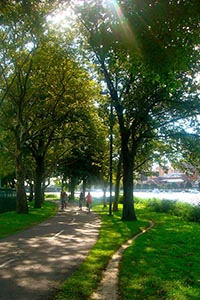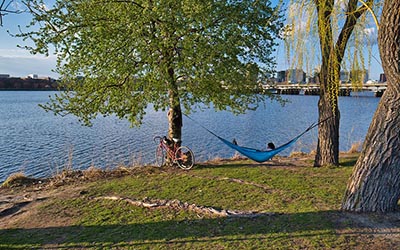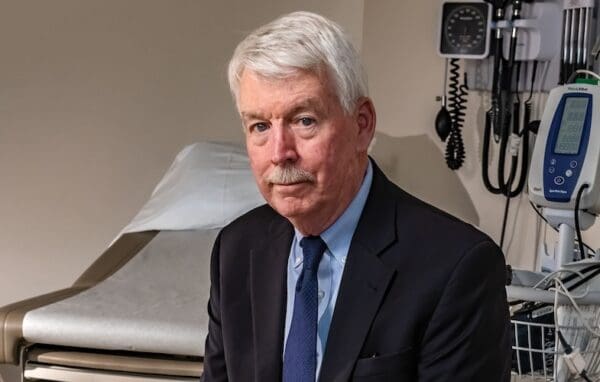People in Allston have been cut off for decades – this project is a chance to reconnect and create a healthier neighborhood. Photo: Nick Allen.
What makes Allston, Allston? Is it the kids playing in the parks, young people catching up on porches, or neighbors gathering at food trucks and farmer’s markets? Allston is all this and more – a place where families, students, and longtime residents connect in shared spaces that reflect the neighborhood’s vibrant spirit. This unique community, one of Boston’s most diverse, thrives on the everyday interactions that connect people.
But for decades, this community where people strive to grow and connect has been cut off by the Mass Pike and filled with a tangle of roads, rail yards, and industrial space. When the Massachusetts Turnpike was built, it sliced through the community, isolating it from the Charles River. Now, MassDOT has a once-in-a-generation opportunity to fix this through the Allston Multimodal Project. But as it stands, the plan doesn’t go far enough.
Allston Multimodal Project: An Opportunity to Reconnect Our Neighborhoods
Assuming it is honored, a $335 million federal grant promised in March 2024 is meant to undo the harm of outdated infrastructure projects that divided and polluted neighborhoods. This includes especially those areas home to immigrant families, low-income residents, and multicultural communities like Allston. But, as it stands, the project’s current plan will fall short.
The proposal to rebuild the Allston interchange – a highway junction where the Mass Pike, Soldiers Field Road, and multiple ramps intersect – aims to straighten the turnpike and fit a complex mix of roadways, rail lines, and walkways into a narrow strip of land between Boston University and the Charles River. The current plan devotes most of that space to 12 highway lanes. So, it leaves less room for safer, more accessible ways for people to get around – like bike lanes, sidewalks, and green spaces.
If MassDOT wants to honor the purpose of this multimodal project and genuinely reconnect Allston, they need to bolster the plan. Here’s how:
1. Prioritize Safety for People
The Allston Multimodal Project should put the safety of pedestrians and cyclists at the forefront. The current plan has pedestrians and cyclists sharing paths along Soldiers Field Road and Cambridge Street. This isn’t safe for anyone. From parents pushing strollers, rushed teens biking to class, and residents walking dogs, all sharing the same space. Let’s be clear, this means different needs would have to compete for limited space. That’s unjust. And so, for this project to meet its purpose – reconnect communities – we need to reduce car lanes, so that people can walk, bike, and have access to green spaces.
These paths aren’t just about getting from A to B – they make Allston safer, more connected, and more vibrant. The area near Cambridge Street and Soldiers Field Road has remained cut off from surrounding neighborhoods due to past highway development. Better walking and biking access can reconnect residents to shops and spark new growth. Expanding space for pedestrians and cyclists would show that Allston’s streets are for everyone – not just those behind the wheel.
2. Build a Healthier, Greener Allston

The health of Allston families should be front and center. Instead of carving out more car lanes, let’s carve out room for trees, shrubs, pollinator gardens, and fresh air – things we can all breathe a little easier with. These green buffers would also shield our precious Charles River from stormwater runoff, filtering pollutants to keep it clean and safe.
This project is a chance to make Allston a place where families can enjoy the outdoors, kids can play in cleaner air, and everyone can take a deep breath without wondering what’s in it. Let’s transform Allston into a place where green pathways outnumber gray highways. That’s a neighborhood that, beyond connected, is more livable and healthier.
3. Give People the Freedom to Choose How They Move
A project called “multimodal” should do exactly what its name promises – give people real choices in how they get around. That means planning for a future where trains, buses, biking, and walking are just as safe, reliable, and convenient as driving. No one should have to call a car service because there were no other viable options.
MassDOT has a chance to prioritize expanding and improving these alternatives. They can ensure people can take the train if they want to, hop on a bus without long wait times, ride a bike safely, or walk to their destination without barriers. When we focus on providing the most options, we all benefit – including those who drive. Less congestion means emergency responders can reach people faster, and those who need to drive for work, errands, or family obligations will enjoy clearer, safer roads.

We should also protect people’s ability to get where they need to go while construction is underway. Families, workers, and students still need reliable ways to reach school, work, and medical appointments. With proper planning, MassDOT can ensure that no one is left stranded during this transition. This project is about building a better-connected Allston. And that starts with making sure people can move freely, every day, from start to finish.
The Future of Allston Is in Our Hands
The Allston Multimodal Project has the potential to be transformative. It offers a chance to right historical wrongs. From prioritizing people’s safety and well-being to reconnecting neighborhoods that have been separated for far too long. Let’s ensure this project becomes what it was meant to be: a gateway to opportunity, a green and healthy space, and a true connector for all of Allston.
Stay tuned for ways to make your voice heard – you have the power to shape Allston’s future. Together, we can build a neighborhood that puts people first.



